The Church of St Lawrence the Martyr
A
real gem in the heart of the town saved from almost certain oblivion by
Ipswich Borough Council (et al.)
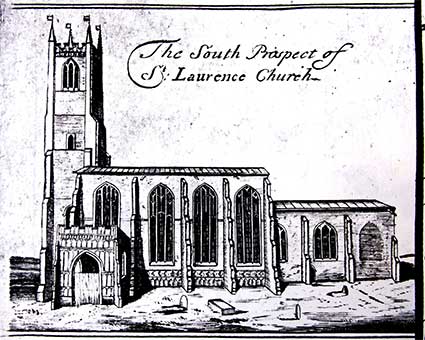 Courtesy Stephen Govier, Suffolk historian
Courtesy Stephen Govier, Suffolk historian
The engraving
above is from John Ogilby's map of
Ipswich, 1674.
Above: St Lawrence Church engraving from John
Ogilby's map of Ipswich, 1674.
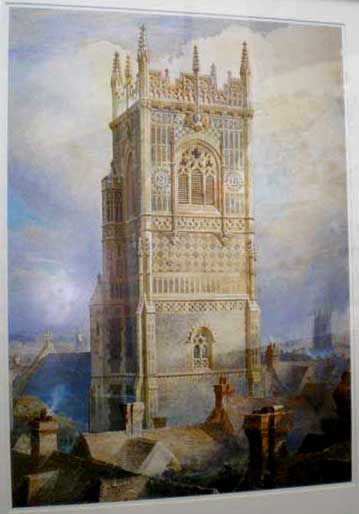
Above: during the
'Our
Town' exhibition held in Christchurch Mansion during the
first Ip-art festival in July 2003, we noticed a wonderful picture of
St
Lawrence Church in Dial Lane painted in a
gorgeous diffuse sunlight by
Howard
Gaye in 1882, presumably from the basket of a hot air balloon! This
prompted
us to seek out the 'lettering of St Lawrence tower.
 Sept.
2023 image
Sept.
2023 image
This really is a rock 'n' roll church tower, thanks to the
lavish budgets of the Victorians. seen here from the lower part of Dial
Lane.
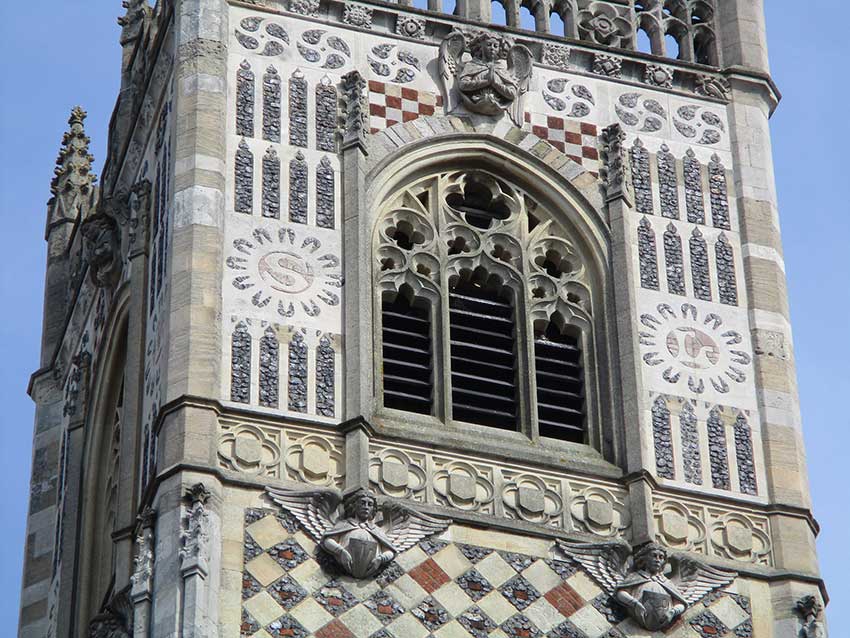
'S'
... 'L'
is seen in decorative
flushwork (a combination of knapped flint, masonry and mortar), the
initials standing, of course, for St Lawrence. The characters an
halo-like surrounds are situated either side of the bell-chamber vent
on the south face of the lofty tower. They could not be repeated on the
north face of the tower because of the spiral staircase feature on the
north-east corner. Incidentally, it is well worth reminding Ipswichians
and others that St Lawrence is of international importance. St Lawrence
Church is a Grade II* listed. The 15th-century church has the oldest
ring of five church bells in the world. When we hear the bells rung on
high days and holidays today, we are listening to the same sound that
the young Thomas Wolsey, born c.1471, heard. The five bell ring at St
Bartholomew, Smithfield is fifty years its junior. For more detail on
the bells, scroll down to the bottom of the page.
Sympathetic cleaning
and restoration, as shown above, has removed industrial revolution
grime to reveal thes splendid colours and decorative features.
The close-up photograph by the late Brian Jepson
shows some of the fine detail here:
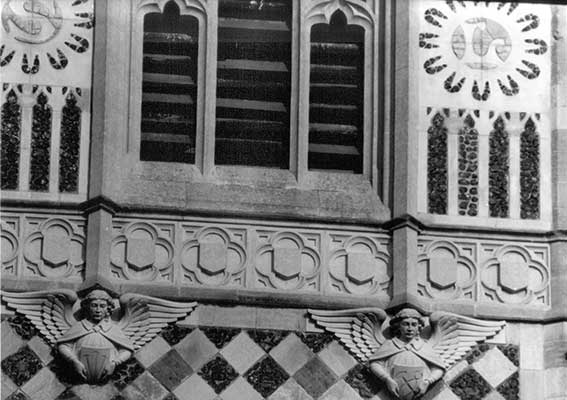 Date not
known, added here 2015
Date not
known, added here 2015
Then we
noticed
some even more obscure characters in the
weather
vein on the very top. Walking up Dial Lane past the church and into
the
lower part of Tower Street the date became visible. Cut out of the metal is the date of '1799'.
Ironic,
too,
that this weather vein spins atop a tower which was built nearly 100
years later. There are other dated weather
vanes in Ipswich.
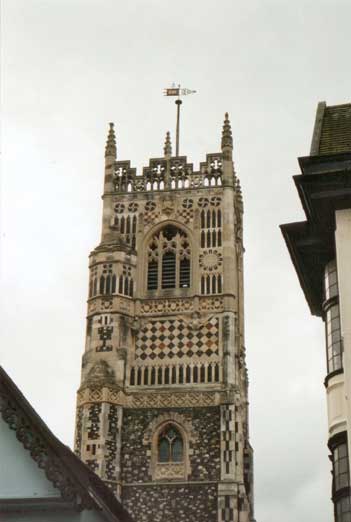
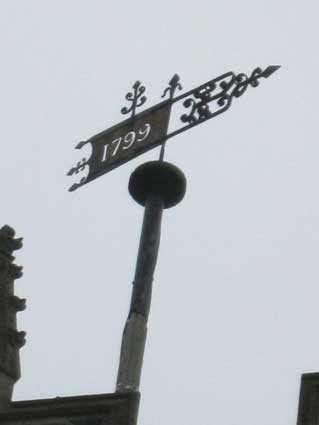 2004
images
2004
images
Having visited St Lawrence in 1990 for a Youngblood
exhibition, we can recall
the amazing blue light through the surviving windows and the truly
marvellous – albeit dirty –
polychrome stone, terra cotta, flint and tile decoration and carvings
in
its lofty tower. On the ground it was not a pretty sight: dirty, worn
stonework,
an abused area surrounding the church –
barely a churchyard – thank
goodness
that the Great Gippeswyckian Carl Giles
celebrated the church towers in
some of his cartoons...
 Giles, 1971. St Mary Le
Tower with St Lawrence in background.
Giles, 1971. St Mary Le
Tower with St Lawrence in background.
The Church of St Lawrence was originally one of the churches of the
Priory of the Holy Trinity, the friary which once stood on the site of
Christchurch Mansion.

Above is 'Ipswich and the Church of St Lawrence' (the view from Tavern
Street down Dial Lane) a steel engraving from Dugdale's England and
Wales Delineated: Curiosities of Great Britain published from
1835 to
about 1848.
Above the close-built shops rises a fine 15th century
tower, its windows outlined in brick, curious little 18th century urns
topping the corners of what is otherwise a typical Suffolk church
tower. So the amazing, decorative top was not always there. See our Scarborow page for an illustration of Dial
Lane in 1830.
In 1882, the London firm of Barnes and Gaye were comissioned to rebuild
the upper part of the tower of St Lawrence church. They produced one
of the most extraordinary confections to grace any Suffolk church, more
noticeably so because of the rarity of Victorian towers in Ipswich in
particular and Suffolk in general. Angels, flowers and mystical symbols
interleave amongst geometric flintwork designs.
Since the tower was cleaned in 1996, the variety of materials used has
become apparent, from brilliant whites and soft pinks to the yellow of
the stonework and iron grey of the flint. Each side of the tower is
different; each view and each perspective has something new to offer.
Our thanks to Simon's Suffolk Churches site (See Links)
for additional information.
After many years of closure and neglect, this disused church was
invested in by Ipswich Borough and Suffolk County Councils as well as
central government in 2008 (every penny from public funds). It is now
fully refurbished and open as a
restaurant. The interior is as impressive as the exterior (scroll down
for images).
The view from St Lawrence Street:
roundels monograms and inscriptions
 2013 image
2013 image
However, the story - from this website's point
of view (insofar
as a website can have a point of view) - does not end there. The
October 2009 issue of the Ipswich Society (see Links)
Newsletter carried an
article by that tireless documenter of local history, Dr John
Blatchly. He has managed to untangle the flushwork (stone and
knapped flint) lettering below the window at the east end of the
exterior of St Lawrence.
The pair of photographs of the site (below) were taken in
January 2011:
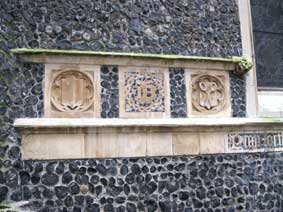
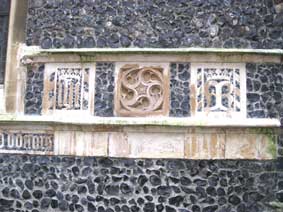
These details are clearer and more recent. See the text below
for explanations of the monograms.
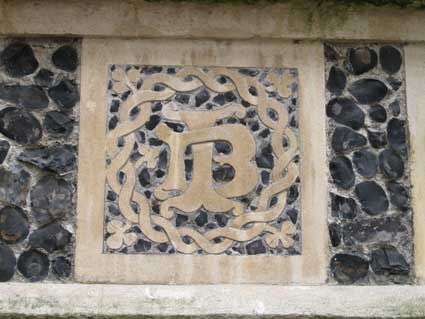
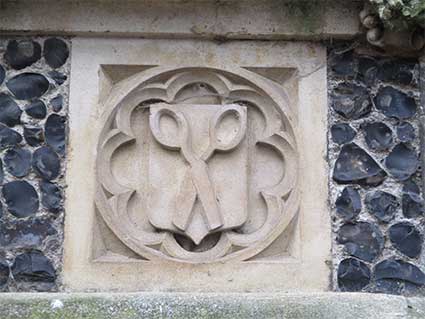
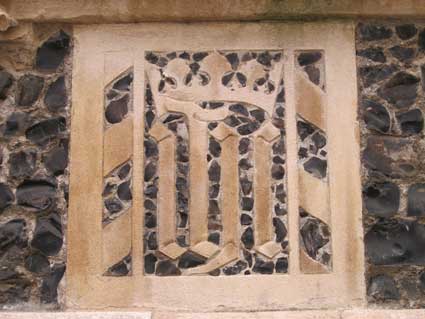
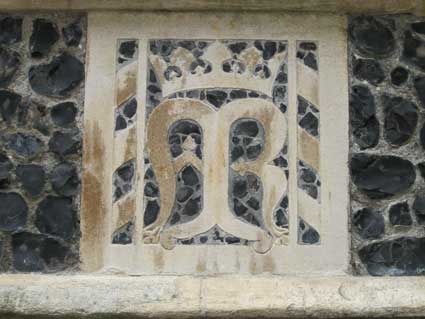 2013 images
2013 images
'ihc'
The flushwork panel to the right is: 'ihc', a fine, recently
restored spiral/circle relief. This is known as the 'sacred monogram';
the letters 'IHC', the first three letters of the Greek word for Jesus
IHCOYC. See also this monogram on the Church
of St Peter.
'AMR'
Then a crowned and rather indecipherable 'AMR'
crowned monogram in flushwork. Simon Knott (see Simon's Suffolk
Churches in Links) tells us that: "it is AMR,
the
conventional monogram for the Blessed Virgin Mary. Most people seem to
think it stands for Ave Maria Regina, although there are other
interpretations." Thanks to him for the demystification. We've found a
similar monogram on St Margaret
(in stone on a butress) and the
flushwork one on St Mary in Woodbridge adds more information:
'This symbol appears in the flint flushwork around the base of the
church tower and the south porch and is repeated on St. Mary's Church
Flag. It is known as the Sacred Monogram of the Blessed Virgin, and
consists of the stylised letters AMR conjoined - the initial letters of
Ave Maria Regina (Hail Mary Queen) - denoting Mary, the Mother of
Jesus, Queen of Heaven. The idea of Mary as Queen of Heaven comes from
Revelation 12.1-5, and is emphasised [in the Woodbridge example] by the
crown and overarching sky. In fact, all five letters of the name MARIA
can be deciphered in this motif.'
'IB'
actually 'JB' – and why the shears?
It is documented that
according to a will of 1488 the
chancel of the church (the bit where the altar stands) was built
largely at the expense of John Baldwyn, a draper; at his death he was
survived by his widow, Joan, but no children.
 2024
composite image
2024
composite image
The long
inscription
Alongside the symbolic
panels which included the shears of his trade an inscription was
included in the east wall:
'Pray for the soules of John Baldwyn
Draper and Jone hys wyf and alle
xtn sowles am'
It is almost as if the letterers didn't quite plan out
the available
space and had to curtail words towards the end: "xtn" stands for
"Christian" - the same as in 'Xmas' (ouch) and "am" is short for
"amen".
Alas, the Victorian restorers/rebuilders of St Lawrence inherited
a building in poor repair, particularly in this area. In 1752 the
dilapidated dedication had been covered with mortar and the 1858
restorers changed 'Jone' to 'Jane' (although this now seems to read
'Jone' once again) and the end of the inscription after
the word "alle" to:
'Pray for the soules of John Baldwyn
Draper and Jone hys wyf and for alle
the
good donors'
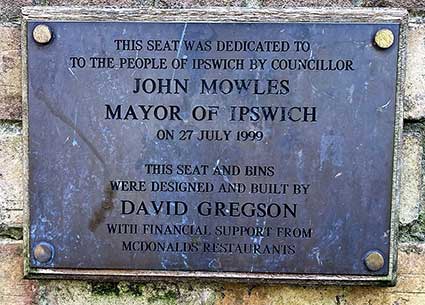 2021
image courtesy Ed Broom
2021
image courtesy Ed Broom
[UPDATE 22.1.2021: 'Walking in
town today I came across this plaque on St Lawrence Street underneath
the "pray for the soules" lettering. Good old McDonalds, eh? One of
your photos shows the old curved seating but at present there is no
seat: maybe temporarily removed given the current situation? Ed Broom.'
Thanks to Ed for photographing the
plaque – and yes, the plaque
was there to the left of our long shot (above). We hear that the wood
of the seat rotted and the whole thing was removed (see the 2024
photograph below.]
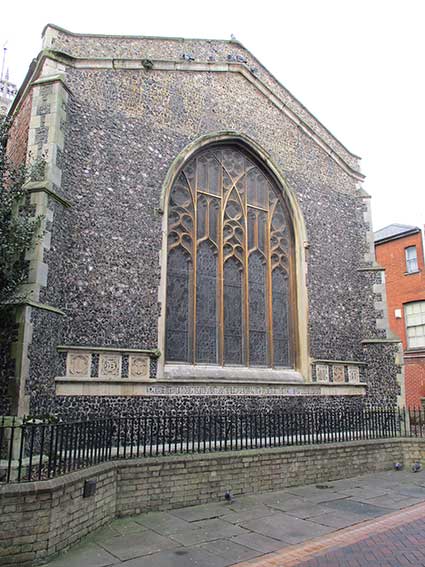 2024
image of the whole east wall
2024
image of the whole east wall
 The
corner of the street with Butter Market (2014)
The
corner of the street with Butter Market (2014)
St Lawrence Street
Muriel Clegg in Streets and street names in Ipswich
(see Reading List): “The central market area retains its medieval pattern, but
of its original names, only Cornhill remains.When a particular market
was moved, the name deserted the site. Thus the removal in 1447 of the
clothmarket from St Lawrence Street to premises’ above and below’ the
Moot Hall on Cornhill, left that street nameless. Even before the
departure of the clothmarket it was often referred to as ‘the lane from
the Fishmarket to the Conduit’. The conduit stood at the western
junction of Tavern Street with St Lawrence Street, its former presence
still indicated by the Town Arms over the
corner premises. Evidently the street became a market for fruit: Ogilby
names it ‘Fruit Market’, and so it continued at least as late as 1823,
but in the meantime the White Hart Inn, there at least as early as
1689, also gave its name to the street, from 1769 (and perhaps earlier)
until the inn was demolished in 1866. With the removal of this landmark
the neighbouring church, as so often happened, bestowed the name St
Lawrence Street.”
For a similar commentary on Dial Lane see our Scarborow
page; on Butter Market see our Ancient House page.
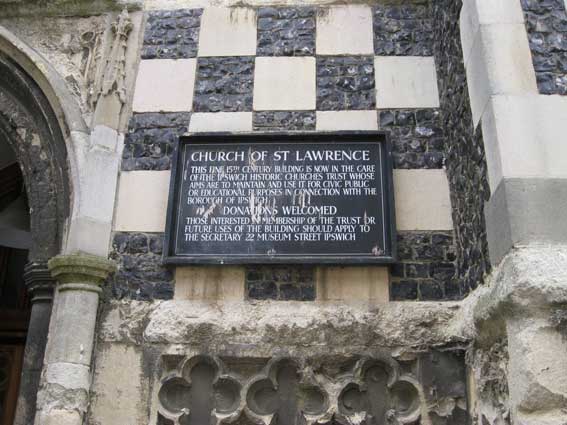 2014 images
2014 images
At the Dial Lane entrance to the church,
this somewhat outdated sign
can still be seen to the right:
'CHURCH OF
ST LAWRENCE
THIS FINE 15TH CENTURY BUILDING IS NOW IN
THE CARE
OF THE IPSWICH HISTORIC CHURCHES TRUST WHOSE
AIMS ARE TO MAINTAIN AND USE IT FOR CIVIC PUBLIC
OR EDUCATIONAL PURPOSES IN CONNECTION WITH THE
BOROUGH OF IPSWICH
DONATIONS WELCOMED
THOSE INTERESTED IN MEMBERSHIP OF THE TRUST OR
FUTURE USES OF THE BUILDING SHOULD APPLY TO
THE SECRETARY 22 MUSEUM STREET IPSWICH'
A few
doors down Dial Lane, see 'Scarborow'
the Art Nouveau shop front of Pickwick's Tea & Coffee shop.
The interior lettering
St Lawrence is notable (as is the closed St
Clement church) for its
extensive lettered frieze and scrolls.
Beatitudes (Psalm 1:1-6; Luke
6:20-23):
'Blessed are the poor in spirit: for theirs is the kingdom of heaven.
Blessed are they that mourn: for they shall be comforted.
Blessed are the meek: for they shall inherit the earth.
Blessed are they which do hunger and thirst after righteousness: for
they shall be filled.'
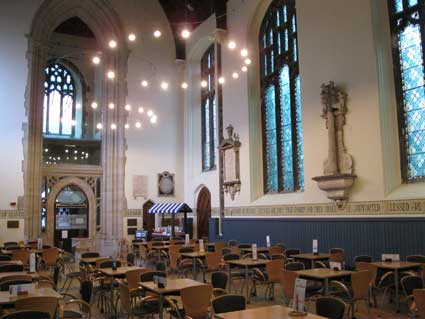
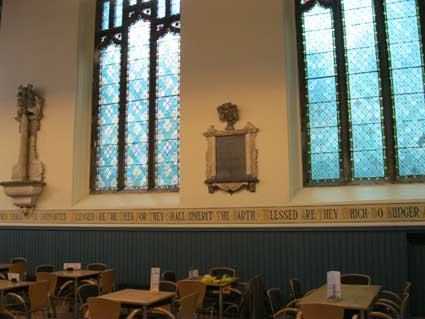 2014 images
2014 images
The first half of the Beatitudes begins to the right of the west door.
Getting into the café early means an almost unobsrtructed view of the
frieze.

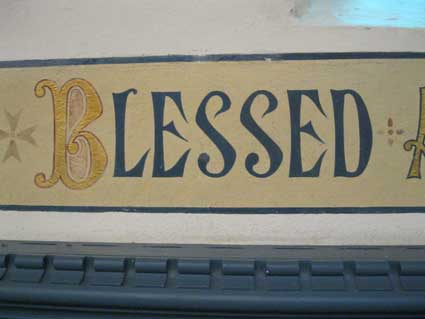
A sculptural element at the base of one memorial
may bestow some comfort....
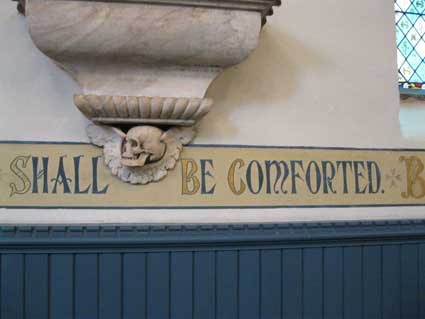
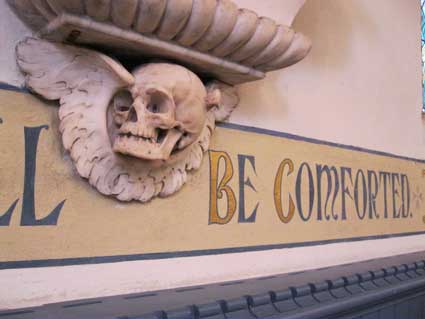
Betwixt 'THE' and 'KINGDOM', a slight inexplicable lozenge reveals part
of a triple-barred 'H' from the original lettering.
See Borin Van Loon's coloured pencil drawing Be comforted based on the above
memorial.

'Blessed are the merciful: for they shall obtain mercy.
Blessed are the pure in heart: for they shall see God.
Blessed are the peacemakers: for they shall be called the children of
God.
Blessed are they which are persecuted for righteousness' sake: for
theirs is the kingdom of heaven.'
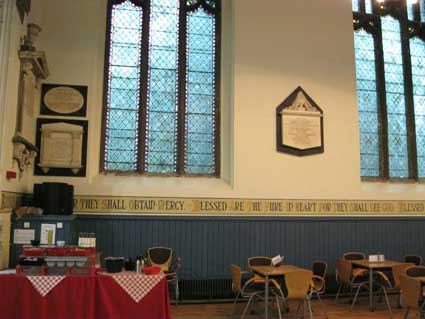
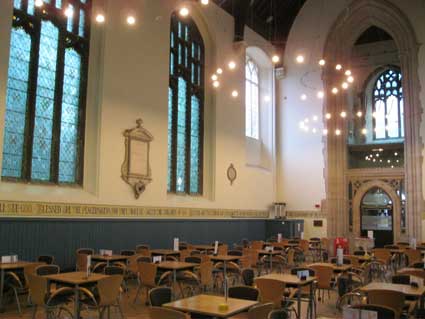
The text continues on the other side of the nave, finally ending to the
left of the west door.
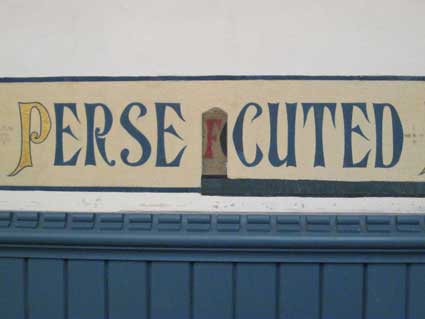
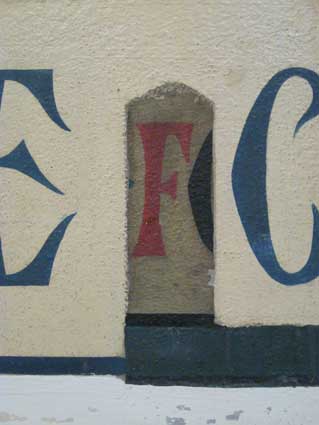
Once again, a slightly odd break in 'PERSE' ... 'CUTED' to reveal an
original initial 'F' in red.
The scroll over the arch into the chancel (similar to that in St
Clement, if memory serves):
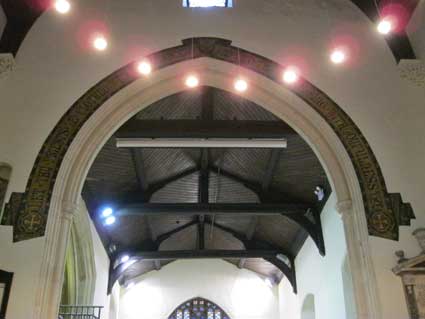
‘LET THY
PRIESTS BE CLOTHED WITH RIGHTEOUSNESS
AND LET THY SAINTS SING WITH JOYFULNESS’
[Psalm 132:9]
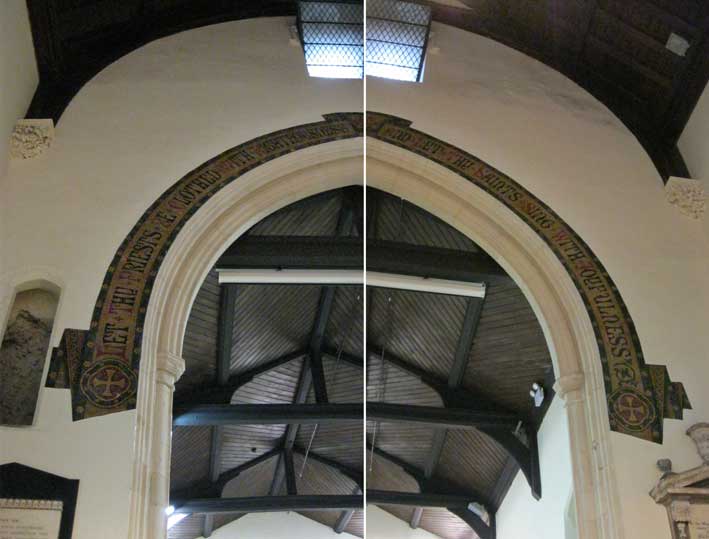
Just one example of the several striking wall memorials:
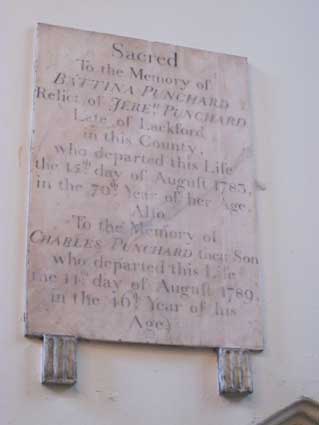
'Sacred
To the Memory of
BATTINA PUNCHARD
Relict of JEREH.
PUNCHARD
Late of Lackford
in this County,
who departed this Life
the 15th day of Auguft 1783,
in the 70th Year of her Age.
Alfo
To the Memory of
CHARLES PUNCHARD
their Son
who departed this Life
the 14th day of Auguft 1789,
in the 16th Year of his
Age.)'
In spite of the odd use of a single closing bracket at
the end, this inscription tells us much of the frailty of human life in
the 18th century
Simon Knott's Suffolk churches website (see Links)
has much information about the remarkable survival and rebirth of St
Lawrence, including a set of photographs of the very poor condition of
the building from September 1999. This includes the original, somewhat
worn Victorian lettering. One wonders if it might have been better to
clean and stabilise the improving texts in their original form, rather
than the overpainting which we (presumably) see today. However, closer
study of these photographs suggests that the smaller Victorian
characters had already been overpainted using larger letters.
If nothing else, St Lawrence is a cause for celebration in
campanological circles as:
"On the ninth of September 2009, the bells of St Lawrence were returned
to their tower for the first time in a quarter of a century. The bells
rang out over the rooftops of Ipswich, and there were emotional scenes,
because these five bells, all cast in the 1440s, are the oldest circle
of five bells in the whole world."
Wolsey's superlative bells
"Only at St Lawrence Church, Ipswich, and at St Bartholomew the Great,
Smithfield, in the City of London, are there rings of five bells
surviving from before the Reformation, and ours are the senior.
The building of the tower at St Lawrence began about 1430 because John
Bottold was described on his slab at the entrance as its 'first
beginner'. In 1447 Thomas Prat's wife Alice left twenty shillings to
'repairing the bells', proof positive that the tower was already built
and the first bells hung. The following year Alice Grenehood, widow,
left the same amount 'to the making of a bell in the tower there' and
in 1451 Christine Hall left more for the same purpose. The Ipswich
bells therefore predate the Smithfield five (all cast in about 1510).
While Thomas Wolsey's parents Robert and Joan lived and probably
worshipped in the neighbouring parish of St Nicholas, Joan's brother,
the wealthy and influential Edmund Daundy, lived in the parish of St
Lawrence and endowed a chantry of St Thomas of Canterbury in the church
where priests would sing masses for the souls of the Daundys and
Wolseys in perpetuity. The sound of bells at his uncle's church will
have been familiar to the young Thomas Wolsey who was born in 1471.
In September 2009 the bells were lowered eight metres and rehung in a
new frame in the sturdy part of the tower where they can be safely
rung. Ringers will come from all over the country, indeed all over the
world, to ring them and hear their uniquely medieval sound, a sound
which Wolsey knew well and is unchanged today.
The five bells and their inscriptions
Two bells honour the Virgin Mary and there is one each for St Thomas of
Canterbury, St Giles, patron saint of blacksmiths, and St Katherine.
The Latin prayers are cast on them in raised letters as follows:-
Treble: 'Sancta Maria Ora Pro
Nobis' [Holy Mary pray for us] Made 1490 by Reignold Chirche of Bury St
Edmunds;
Second: 'Sancta Katerina Ora
Pro Nobis' [Holy Katherine pray for us] Made about 1440 by William
Chamberlain of London;
Third: 'Sonitus Egidii Ascendit
Ad Culmina Celi' [The sound of Giles rises to the vaults of heaven]
Made about 1449 by Richard Brasyer 1 of Norwich;
Fourth: 'Nos Thomas Meritis
Mereamur Gaudia Lucis' [May we deserve the joys of light by the merits
of Thomas ] Made about 1449 by Richard Brasyer;
Tenor: 'Sum Rosa Pulsata Mundi
Maria Vocata' [I am, when rung, called Mary the Rose of the World] Made
about 1449 by Richard Brasyer".
John Blatchly
(Edited article from The Ipswich
Society Newsletter (see Links),
January 2010.)
Home
Please email any comments and contributions by clicking here.
Search Ipswich
Historic Lettering
©2004 Copyright
throughout the Ipswich
Historic Lettering site: Borin Van Loon
No reproduction of text or images without express written permission

 Courtesy Stephen Govier, Suffolk historian
Courtesy Stephen Govier, Suffolk historian
 Sept.
2023 image
Sept.
2023 image
 Date not
known, added here 2015
Date not
known, added here 2015
 2004
images
2004
images  Giles, 1971. St Mary Le
Tower with St Lawrence in background.
Giles, 1971. St Mary Le
Tower with St Lawrence in background.

 2013 image
2013 image




 2013 images
2013 images 2024
composite image
2024
composite image 2021
image courtesy Ed Broom
2021
image courtesy Ed Broom 2024
image of the whole east wall
2024
image of the whole east wall The
corner of the street with Butter Market (2014)
The
corner of the street with Butter Market (2014) 2014 images
2014 images
 2014 images
2014 images










